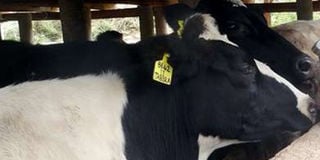More milk, low returns: Why you should think twice about zero-grazing

Dairy cattle in a zero-grazing unit. Costs are high under the zero-grazing system since it is the most input intensive system of dairy farming. FILE PHOTO | NATION MEDIA GROUP
What you need to know:
- Zero-grazing is the most efficient production system.
- However, the good outlook of the zero-grazing system dulls when costs are considered.
- Profitability of the semi-zero grazing system overtakes that of the zero-grazing system.
- It supports more than a million smallholders and plays a critical role in food and nutrition security through milk consumption and increased household incomes.
As population rises and average land sizes shrink, zero-grazing has become the model of choice for many farmers, who believe that the system is efficient and offers high returns.
But is this the case? Tegemeo Institute partnered with the Kenya Dairy Board to seek answers to this question and others in a recent study undertaken in 20 counties that are important in milk production.
Farmers interviewed ranged from those practising zero-grazing to those undertaking open grazing.
Results of the study are somewhat startling.
To begin with, no doubt, our study found out that zero-grazing is the most efficient production system.
Despite expected differences by counties, farmers practising zero-grazing had the highest milk productivity at an average of 9.2 litres/cow/day compared to 6.8 litres for semi-zero grazers and four litres for the open grazers.
Thus, the zero-grazing system gives the highest per unit revenue on average, translating to Sh103,773 worth of milk per cow per year.
The other systems, the study showed, return Sh84,430 (semi-zero) and Sh39,030 (open).
However, the good outlook of the zero-grazing system dulls when costs are considered. Our study found out that costs are highest for the zero-grazing system.
Without accounting for own factors of production and fixed costs, an average zero-grazer spent Sh62,081 per cow, per year, compared to Sh42,851 for semi-zero grazers and Sh15,197 for open grazers.
This leads to a gross margin of Sh41,691 per cow per year for zero-grazers, closely followed by the semi-grazing system at Sh41,579, and Sh23,832 for open grazing.
EFFICIENCY OBSERVED
The high cost for zero-grazers, therefore, equalled their gross margins to those of semi-zero grazers, despite zero-grazing resulting in higher milk production and revenues from milk.
The largest direct cost components for zero-grazers were feed concentrates and hired labour, contributing 42 per cent and 18 per cent to total costs respectively.
Therefore, accounting for full costs of milk production, including own factors of production and fixed costs, we found that profitability of the semi-zero grazing system overtakes that of the zero-grazing system.
Full costs of milk production amount to Sh102,963 per cow per year for zero-grazers, Sh71,076 for semi-zero grazers and Sh29,090 for open grazers.
The zero-grazers, thus, return the lowest profit at Sh809 per cow per year, versus Sh13,354 for semi-zero grazers and Sh9,940 for open grazers.
Labour (including family labour) is the largest component of total cost contributing 38 per cent followed by feed concentrates at 23 per cent.
The study found that profits are lowest under this system due to two reasons. First, the efficiency observed under this system in terms of milk productivity and consequently revenue from milk is not high enough to offset the incremental costs that come with intensification.
HIGH COSTS
Even if productivity in some counties is higher, an average productivity of 9.2 litres/cow per day as observed in the study is clearly low for zero-grazing system.
Increased productivity would increase profitability substantially.
Simulations showed that if average productivity is increased by merely 30 per cent, translating to an average of 12 litres per cow per day, profits for zero-grazing would increase to Sh31,940/cow/year.
A productivity increase to an average of 15 litres per cow, per day (63 per cent increase), lifts profits to Sh66,227 per cow/year. Clearly, policy measures are required to address low productivity under zero-grazing.
Adoption of improved breeds, addressing quality issues in feed concentrates, and improved feeding practices are some of the means to achieve this increased productivity.
Secondly, costs are highest under the zero-grazing system since it is the most input intensive system.
Possible ways to address the high cost of feed concentrates and labour include dealing with feed quality issues, promoting feed formulation at farm-level, lowering tax regimes, and exploring small-scale mechanisation.
Dr Kimenju is a Research Fellow at Tegemeo Institute, Egerton University.
***
Crucial Industry
Dairy Contributes 4pc of GDP
Dairy is an important industry in Kenya contributing about 14 per cent of the agriculture GDP and 4 per cent of the National GDP.
It supports more than a million smallholders and plays a critical role in food and nutrition security through milk consumption and increased household incomes.
It is estimated that about 80 per cent of milk is produced by smallholders. Due to these factors, in addition to the commercial orientation in the dairy industry in Kenya, the sub-sector has the potential of playing an important role in improving the livelihoods of small-scale farmers hence also contributing to poverty reduction.
However, there are several challenges in the sector including low productivity and high costs of production, which may compromise the extent to which the industry can contribute to these goals.
Additionally, the system of production practised may affect performance.
As average per household land sizes continue to shrink, many farmers are shifting to zero-grazing system.




